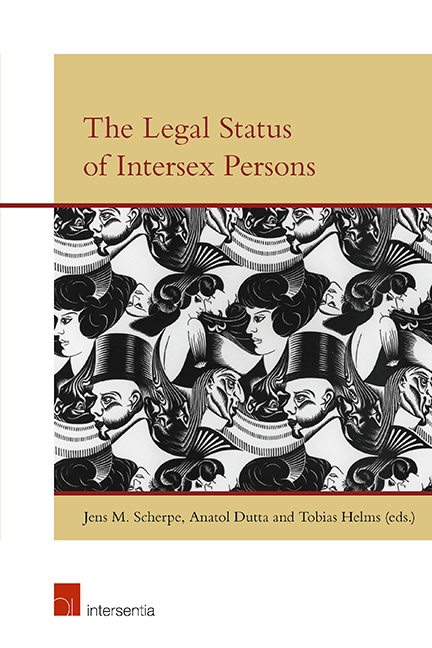Book contents
- Frontmatter
- Preface
- Contents
- List of Contributors
- The Legal Status of Intersex Persons: An Introduction
- Malta Declaration
- Darlington Statement
- Vienna Statement
- PART I MEDICINE AND PSYCHOLOGY
- PART II THEOLOGY AND LEGAL HISTORY
- PART III TRANSGENDER, TRANSSEXUALITY AND INTERSEX
- PART IV NATIONAL LEGAL DEVELOPMENTS
- Australia
- Sweden
- India
- The Netherlands
- France
- Colombia (The Colombian Constitutional Court)
- United States
- Malta
- Germany (The 2013 German Law)
- Germany (German Inter-Ministerial Working Group)
- Germany (Gender Diversity in Law)
- PART V PRIVATE INTERNATIONAL LAW ASPECTS OF INTERSEX
- PART VI INTERSEX AND HUMAN RIGHTS
India
from PART IV - NATIONAL LEGAL DEVELOPMENTS
Published online by Cambridge University Press: 31 January 2019
- Frontmatter
- Preface
- Contents
- List of Contributors
- The Legal Status of Intersex Persons: An Introduction
- Malta Declaration
- Darlington Statement
- Vienna Statement
- PART I MEDICINE AND PSYCHOLOGY
- PART II THEOLOGY AND LEGAL HISTORY
- PART III TRANSGENDER, TRANSSEXUALITY AND INTERSEX
- PART IV NATIONAL LEGAL DEVELOPMENTS
- Australia
- Sweden
- India
- The Netherlands
- France
- Colombia (The Colombian Constitutional Court)
- United States
- Malta
- Germany (The 2013 German Law)
- Germany (German Inter-Ministerial Working Group)
- Germany (Gender Diversity in Law)
- PART V PRIVATE INTERNATIONAL LAW ASPECTS OF INTERSEX
- PART VI INTERSEX AND HUMAN RIGHTS
Summary
INTRODUCTION
On 15 April 2014, the Supreme Court of India (the Court) handed down judgment in National Legal Services Authority v. Union of India (NALSA). NALSA recognised the identities and rights of Hijra and transgender persons in law, echoing earlier decisions by neighbouring countries, Pakistan and Nepal. By embracing Hijras and transgender persons within its constitutional fold, the judgment in NALSA made a promise to them of the promotion and protection of fundamental rights as enshrined within the Constitution of Indian (the Constitution).
Upon its arrival, NALSA was in turn hailed as ‘landmark’ and as ‘embodying a long tradition of openness by the Court by simultaneously celebrating the universal idea of humanity and values, while emphasising the importance of national and local identities’ and derided for vague unenforceable orders and making ‘gross generalisations ‘about Hijra and transgender persons, slipping as it did in and out of’ different notions of transgender identity ‘pointing to’ an administrative nightmare without further clarification ‘.
Delineations in law are important; otherwise uncertainty remains as to whom the Court's newly announced recognition applies. For intersex persons this can become an acute problem – intersex persons may be straight, gay, lesbian, bisexual, asexual, and may identify as female, male, both or neither. This ability to transcend and traverse sexual orientations and gender identities has rendered intersex persons almost invisible and uniquely vulnerable, as if unnecessary of recognition and protection in the law. The lives of individuals with non-conforming sex binary bodies can be a precarious one of fear and violence, attempting to fit into the sex binary. 10
NALSA appeared to open a space for challenging the gender binary straitjacket by recognising and protecting gender variations in law in India. Recognition in law is the passport to identification documents, which in turn enables access to other fundamental rights, such as housing, welfare benefits, education and healthcare. This chapter asks what does NALSA mean for intersex persons in India? Does the promise made to Hijra and transgender persons include or extend to intersex individuals? On one level, the answer will inevitably lie in how NALSA is interpreted and applied; Jackuline Mary v.
- Type
- Chapter
- Information
- The Legal Status of Intersex Persons , pp. 281 - 292Publisher: IntersentiaPrint publication year: 2018



